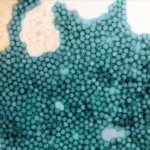Link to Pubmed [PMID] – 22457288
J. Infect. Dis. 2012 May;205(9):1363-73
BACKGROUND: Five cases of poliomyelitis due to type 2 or 3 recombinant vaccine-derived polioviruses (VDPVs) were reported in the Toliara province of Madagascar in 2005.
METHODS: We sequenced the genome of the VDPVs isolated from the patients and from 12 healthy children and characterized phenotypic aspects, including pathogenicity, in mice transgenic for the poliovirus receptor.
RESULTS: We identified 6 highly complex mosaic recombinant lineages composed of sequences derived from different vaccine polioviruses and other species C human enteroviruses (HEV-Cs). Most had some recombinant genome features in common and contained nucleotide sequences closely related to certain cocirculating coxsackie A virus isolates. However, they differed in terms of their recombinant characteristics or nucleotide substitutions and phenotypic features. All VDPVs were neurovirulent in mice.
CONCLUSIONS: This study confirms the genetic relationship between type 2 and 3 VDPVs, indicating that both types can be involved in a single outbreak of disease. Our results highlight the various ways in which a vaccine-derived poliovirus may become pathogenic in complex viral ecosystems, through frequent recombination events and mutations. Intertypic recombination between cocirculating HEV-Cs (including polioviruses) appears to be a common mechanism of genetic plasticity underlying transverse genetic variability.
